| | Published February 27th, 2013
| Digging Deep with Cynthia Brian Branching Out
| | By Cynthia Brian | 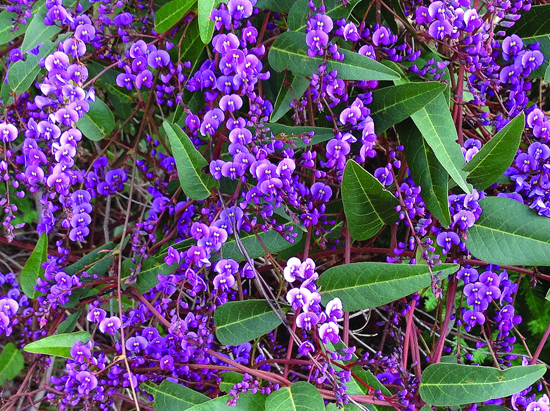 | | An old fence gets a colorful make-over with Hardenbergia violaceae, the purple lilac vine
| "A liquid moon moves gently among the long branches. Thus having prepared their buds against a sure winter, the wise trees stand sleeping in the cold." William Carlos Williams
I was wrong! Oh, so wrong! And how thrilled I am that I was. One would think that history would be the precedent, but as in stock warnings, past performance is not an indicator of the future. After decades of dismal, dreary, drab Februarys, Mother Nature decided to march on with an early spring in the second month of this new year! Only a few wet weather days tarnished the mostly sunny daylight hours, frosty mornings, and very cold nights. It has been a cheery month, not dreary in the least.
By mid February, my daffodils, crocus, flowering pears and flowering peaches were in full bloom. The birds were singing, the bees were buzzing, and I was dancing in the dirt. Because of the gorgeous weather, much needed hardscape repairs were accomplished chez moi. This year while I was outside benefiting from the sun's rays, I took the time to really study the beautiful structure of trees in their dormant splendor, something that rarely occurs with inclement weather.
In winter months, unless we are in the Sierras admiring the snow-clad conifers, most of us tend not to take a good look at our leafless trees. We enjoy the beautiful spring flowers and the fabulous fall foliage, without ever paying attention to the bare bark. Although as children we normally color branches with a brown crayon, most trees are every color but brown, exhibiting a variety of shades including maroon, gray, yellow, orange, and white. For example, my striking Japanese maple "Sango Kabu" has striking coral red branches that glitter in the sunlight.
The outer bark is the tree's protection from the elements. Tree bark can be smooth, textured, velvety, prickly, patchy, peeling, dull, or bright. On a clear blue-sky day, bark shimmers and shines, and when situated against a backdrop of evergreens, the trunks are a visual treat. Of course, evergreen specimens are of interest as well, such as the heavily textured slivers of redwood.
A few of my favorite tree
barks include:
Crape Myrtle
White Birch
Japanese Maple
Tulip Magnolia
Palm
Golden Chain
Pear
Horsechestnut
Mulberry
Walnut
Olive
Cottonwood
Pistache
If a tree is pruned, the style in which it is pruned becomes another ornamentation. One of the most fascinating styles is pollarding, an age-old pruning technique supposedly originated in Holland, adding drama and beauty to winter stems. It was used to harvest firewood for heating and saplings for wooden shoes without killing the tree. Today it is utilized mostly on city trees to contain size but when done consistently, the tree becomes an art piece. With pollarding, a gardener cuts back the main limbs of the tree. In the spring, new shoots grow below the cuts and are then removed. After a few of these heavy cuttings, gnarly stubs form at the top of the tree. A pollarded tree must continue to be pollarded every year to two years otherwise it risks developing weak shoots that push against one another allowing moisture to enter the wood which eventually rots and kills the tree. Some trees that are commonly pollarded include locust, linden, willow, redbud, mulberry, beech, horsechestnut, and poplars. A great place to enjoy pollarded trees is in the band concourse between the Academy of Arts and Sciences and the de Young Museum in Golden Gate Park in San Francisco. They eerily remind one of a haunted forest where the trees awaken, talk, and follow the traveler.
Before all the leaves spring forth in your home forest, take a walk outside with your camera to snap the anatomy of a bare tree. Look for interesting pruning techniques as you drive the suburban roads, and savor the fragrance of the fruit trees in blossom.
Branch out!
|
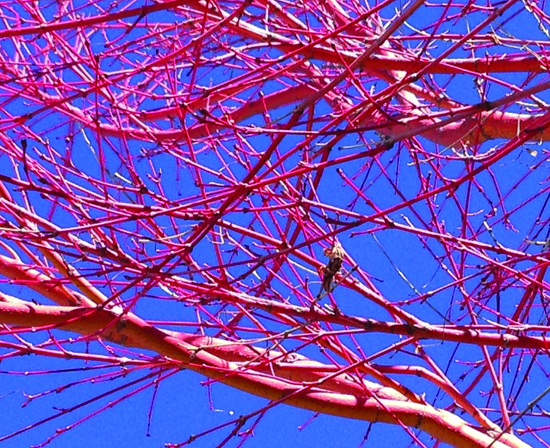 | | The coral colored twigs of the red branch Japanese maple add sparkle to the blue sky.
| 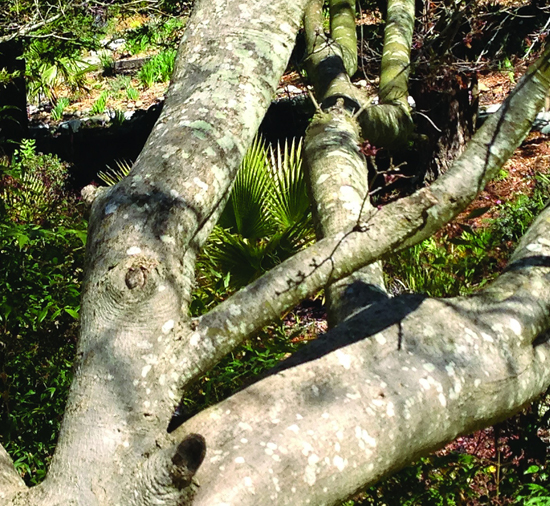 | | The mottled trunk of a Japanese maple is beautiful any time of year. Photos Cynthia Brian
|  | | The crape myrtle tree offers four seasons of beauty, including the peeling and colorful bark.
| 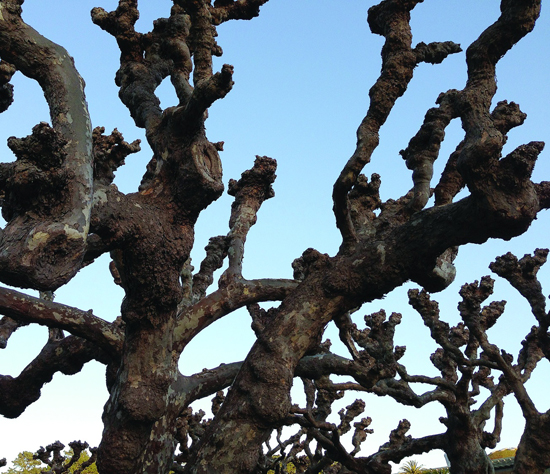 | | The knots and gnarls of a pollarded tree is reminiscent of a haunted forest.
| |
|
Cynthia Brian's Gardening Guide for March
"If a bud burst into bloom every time I thought of you, all the earth would be a glorious garden." Catherine Atkinson
Fruit tree buds are swollen this month and are especially handsome as the buds open to flower and the leaves slowly unfurl. Growth is evident daily and it's especially rewarding to cut a branch for indoor gazing. Try a flowering peach, pear, or cherry for a long lasting experiment in watching nature come alive. With the month of March heralding in the "real" spring, now is the time to check our brown thumbs at the garden gate and dive in with the green.
- IMPROVE your homes value by adding trees to the landscape. It is estimated that landscaping along with mature trees can add anywhere from 10 to 20 percent to your home's property value.
- PLANT early blooming pollinators including California poppy, chives, larkspur dianthus, lupine, pea, viola, and sweet alyssum.
- EAT broccoli. Broccoli is one of the world's most nutritious vegetables. It energizes us with vitamins C, K, and A as well as folate, manganese, potassium and magnesium. It is high in fiber and
protein as well as flavonoids that reduce inflammation, and phytonutrients that help the body detoxify. It could be the most multi-tasking vegetable ever.
- SOAK the seeds of bean sprouts each Sunday and you'll have a fresh week's worth of sprouts by Friday.
- GO au natural. Spend time outdoors in natural settings. Being in touch with nature is essential to good health of mind, body, and spirit.
- ELIMINATE pesticides from your gardening tool kit. They are detrimental to beneficial insects and humans.
- START seeds inside now for transplanting next month to your garden space.
- INCREASE visual and nutritional interest by planning to plant vegetables and herbs in ornamental containers close to your kitchen door. You won't sacrifice flavor and functionality will soar.
- START your spring gardening by improving the soil. Gardens are often missing the microorganisms and nutrients needed for a thriving crop.
- CLUMP flowers together in areas measuring four feet diameter or more to attract bees, butterflies, and birds.
- FERTILIZE fruit trees and flowering shrubs with a high nitrogen solution.
- DIVIDE perennials such as daylilies and agapanthas.
- VISIT the de Young Museum's exhibit of Bouquet of Arts for an invasion of flowers and masterpieces March 19-23. For tickets, go to https://tickets.famsf.org.
- RE-SEED or plant a new lawn during this spring weather. Commence weekly mowing for sturdier growing. For best results, do not use a leaf bag but instead allow the clippings to compost on
the grass naturally.
- BRIGHTEN a weary fence with the purple lilac vine that resembles sweet peas,
Hardenbergia violaceae.
- SPRAY aphids with a strong blast from the hose. If more attention is needed, fill a spray
bottle with dish washing detergent mixed with water to douse the pests.
- CLEAN fountains, ponds, birdbaths, and other water features to welcome our flying
friends home for the warmer weather.
- HOWL at the moon at the vernal equinox on March 20, the real first day of spring when
day and night are exactly 12 hours each!
- SHOOT photos of your naked trees and more as they begin to don their spring
wardrobe.
The buds are bursting into bloom as I think with love of all my two-footed and four-footed friends. Life is a glorious garden.
Happy gardening to you!
(c)2013
Cynthia Brian
The Goddess Gardener
Cynthia@goddessgardener.com
www.goddessgardener.com
925-377-7827
Cynthia is available as a speaker and consultant.
|
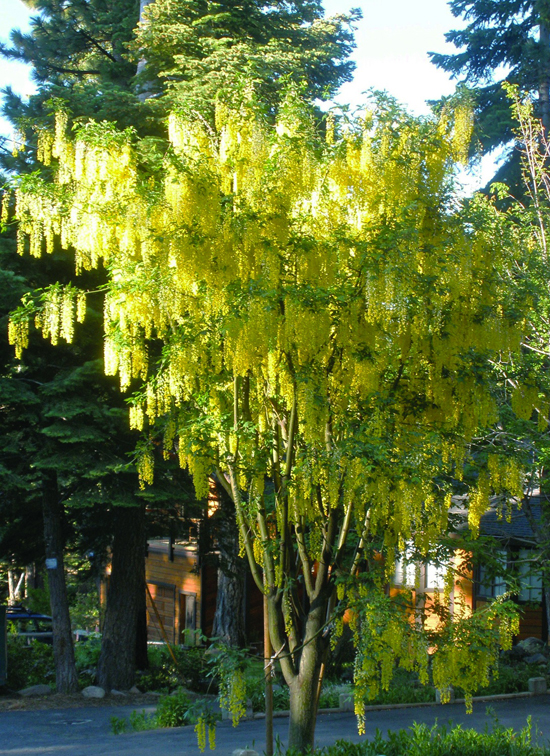 |
Who can resist the shimmering clusters of brilliant blooms of the Golden Chain tree?
Photos Cynthia Brian |
|
|
|
| | | | | |
| | | print story
Before you print this article, please remember that it will remain in our archive for you to visit anytime.
download pdf
(use the pdf document for best printing results!) | | | Comments | | |
| | | | | | | | | | | | | | | | |







